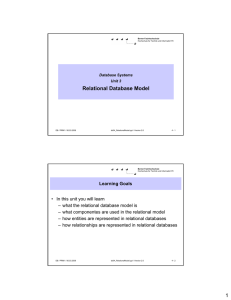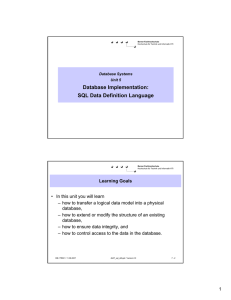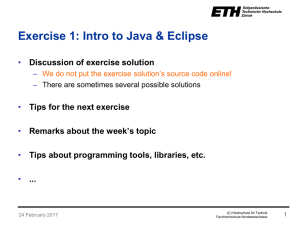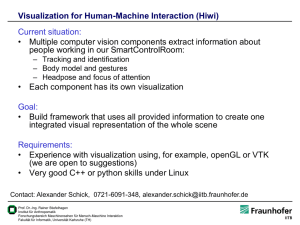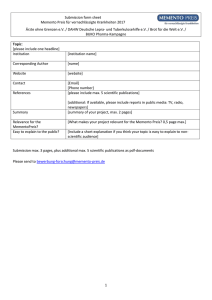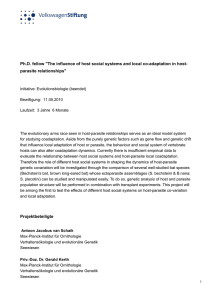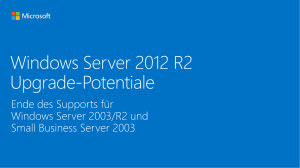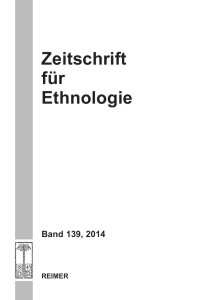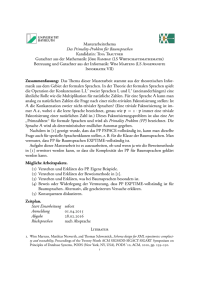Introduction Dr. Jürgen Eckerle - BFH-TI / Organisation
Werbung
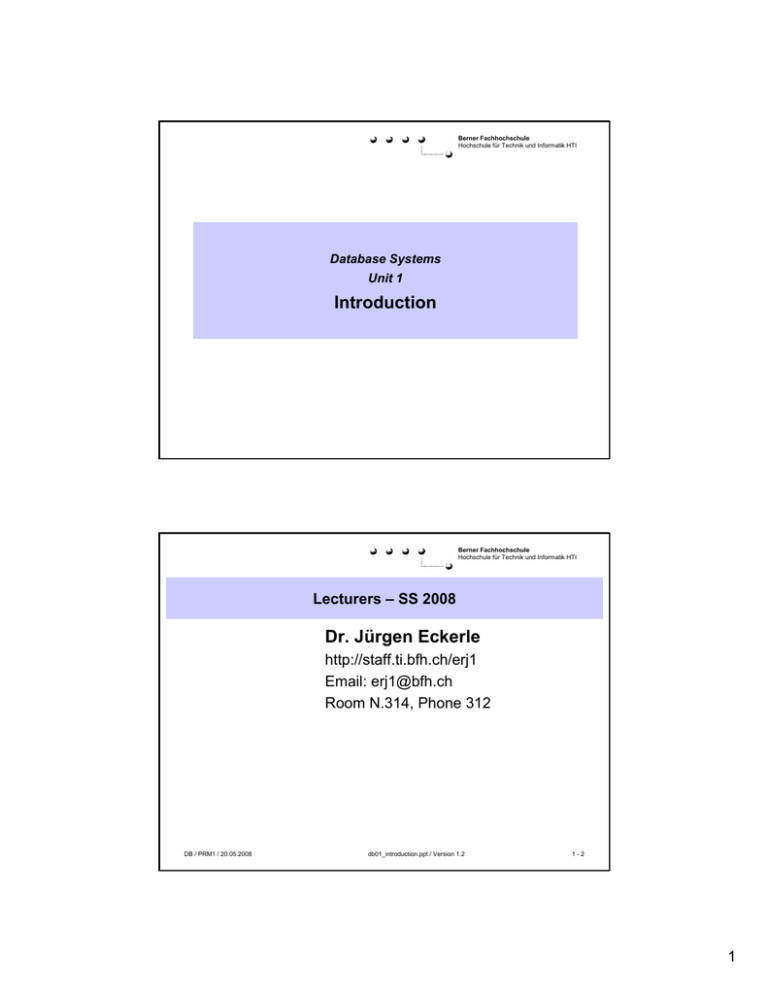
Berner Fachhochschule Hochschule für Technik und Informatik HTI Database Systems Unit 1 Introduction Berner Fachhochschule Hochschule für Technik und Informatik HTI Lecturers – SS 2008 Dr. Jürgen Eckerle http://staff.ti.bfh.ch/erj1 Email: [email protected] Room N.314, Phone 312 DB / PRM1 / 20.05.2008 db01_introduction.ppt / Version 1.2 1-2 1 Berner Fachhochschule Hochschule für Technik und Informatik HTI Lecturers – SS 2006 Marcel Pfahrer Lic. rer. pol., dipl. Ing. HTL http://prof.hti.bfh.ch/prm1 Email: [email protected] Room N.622, Phone 335 Rolf Jufer-Meier Lic. oec. publ., dipl. Wirtschaftsinformatiker http://prof.hti.bfh.ch/?id=rolfjufer Email: [email protected] Room N.622, Phone 463 DB / PRM1 / 20.05.2008 db01_introduction.ppt / Version 1.2 1-3 Berner Fachhochschule Hochschule für Technik und Informatik HTI Course Information • Course materials – Slide copies – Exercises – A book: “Fundamentals of Database Systems”. – Additional material: On my homepage. • Grading – One written exam during semester – Written final exam (integrated with “Programming 2”) • Database System – Microsoft SQL Server 2005 DB / PRM1 / 20.05.2008 db01_introduction.ppt / Version 1.2 1-4 2 Berner Fachhochschule Hochschule für Technik und Informatik HTI Accompanying Book • Elmasri, R. / Navathe, S.B. Fundamentals of Database Systems 4th Edition, Pearson, 2004, ISBN 0-321-20448-4 • Elmasri, R. / Navathe, S.B Grundlagen von Datenbanksystemen 3. Auflage, Pearson, ISBN 3-8273-7136-8 • Elmasri, R. / Navathe, S.B Conception et architecture de base de données 4ème édition, Pearson, ISBN 2-7440-7055-6 DB / PRM1 / 20.05.2008 db01_introduction.ppt / Version 1.2 1-5 Berner Fachhochschule Hochschule für Technik und Informatik HTI Why a Course on Database Systems? • In the course of a day, most of us encounter several activities that involve some interaction with a database. For example, – if we go to a bank to deposit or withdraw funds, – if we make a hotel or airline reservation, – if we access a computerized library catalog to search for a bibliographic item, or – if we buy some item – such as a book, toy, or computer – from an Internet vendor through its Web page. DB / PRM1 / 20.05.2008 db01_introduction.ppt / Version 1.2 1-6 3 Berner Fachhochschule Hochschule für Technik und Informatik HTI Why a Course on Database Systems? • Today, information is a key resource and is still growing in importance and volume. • Data allows to represent information. • Databases help us to – store it (file structures, disk management) – understand it (data models) – keep it secure (security, recovery) – find it and use it (query languages, concurrency control and data analysis tools) DB / PRM1 / 20.05.2008 db01_introduction.ppt / Version 1.2 1-7 Berner Fachhochschule Hochschule für Technik und Informatik HTI Learning Goals • In this lesson you will learn – How data base systems are structured and what are the elementary concepts – How data and their relationships are modelled using the Entity-Relationship-Model – The relational data model and relational database constraints – The Relational Algebra and the relational calculus – The data manipulation language SQL – Normalizations for Relational Databases DB / PRM1 / 20.05.2008 db01_introduction.ppt / Version 1.2 1-8 4 Berner Fachhochschule Hochschule für Technik und Informatik HTI What is a Database? • A definition in a very broad sense „A Database (DB) is a collection of related data.“ DB / PRM1 / 20.05.2008 db01_introduction.ppt / Version 1.2 1-9 Berner Fachhochschule Hochschule für Technik und Informatik HTI Characteristics of a Database • A database represents some aspect of the real world, sometimes called the miniworld or the Universe of Discourse (UoD). Changes to the UoD are reflected in the database. • A database is a logically coherent collection of data with some inherent meaning. A random assortment of data cannot correctly be referred to as a database. • A database is designed, built, and populated with data for a specific purpose. It has an intended group of users and some preconceived applications in which these users are interested. DB / PRM1 / 20.05.2008 db01_introduction.ppt / Version 1.2 1 - 10 5 Berner Fachhochschule Hochschule für Technik und Informatik HTI Characteristics of a Database In other words, a database • has some source from which data is derived, • some degree of interaction with events in the real world, and • an audience that is actively interested in the contents of the database. DB / PRM1 / 20.05.2008 db01_introduction.ppt / Version 1.2 1 - 11 Berner Fachhochschule Hochschule für Technik und Informatik HTI More Characteristics of Databases (Atzeni et al., 2000) • Databases can be large – certainly larger than the main memory available • Databases are shared – various applications and users must be able to gain access to data of common interest – redundancy (and, consequently) the possibility of inconsistencies is reduced • Databases are persistent – they have a lifespan that is not limited to single executions of the programs that use them DB / PRM1 / 20.05.2008 db01_introduction.ppt / Version 1.2 1 - 12 6 Berner Fachhochschule Hochschule für Technik und Informatik HTI What is a Database? • A definition in a much closer sense „A Database is a collection of data managed by a DBMS.“ DB / PRM1 / 20.05.2008 db01_introduction.ppt / Version 1.2 1 - 13 Berner Fachhochschule Hochschule für Technik und Informatik HTI What is a Database? „A Database Management System (DBMS) is a collection of programs that enables users to create and maintain a database.” • The DBMS is hence a general-purpose software system that facilitates the process of – defining, – constructing, – manipulating, and – sharing databases among various users and applications. DB / PRM1 / 20.05.2008 db01_introduction.ppt / Version 1.2 1 - 14 7 Berner Fachhochschule Hochschule für Technik und Informatik HTI What is a Database? • Additionally, – protection including both • system protection against hardware or software malfunction (or crashes), and • security protection against unauthorized or malicious access. – maintain the database system by allowing the system to evolve as requirements change over time. DB / PRM1 / 20.05.2008 db01_introduction.ppt / Version 1.2 1 - 15 Berner Fachhochschule Hochschule für Technik und Informatik HTI What is a Database System? „A Database System (DBS) is a DBMS together with one or more Databases managed by this DBMS.” DB / PRM1 / 20.05.2008 db01_introduction.ppt / Version 1.2 1 - 16 8 Berner Fachhochschule Hochschule für Technik und Informatik HTI DB / PRM1 / 20.05.2008 db01_introduction.ppt / Version 1.2 1 - 17 Berner Fachhochschule Hochschule für Technik und Informatik HTI Information and Data • Every organisation has an Information System to manage the information necessary to perform the functions of the organisation • The existence of the information system is partly independent of the extent to which it is automated • Information may be recorded by means of Data „... data alone has no significance, but once interpreted and suitably correlated, it provides information that allows us to improve our knowledge of the world.“ Atzeni et al., 2000, p. 3 DB / PRM1 / 20.05.2008 db01_introduction.ppt / Version 1.2 1 - 18 9 Berner Fachhochschule Hochschule für Technik und Informatik HTI Example DB / PRM1 / 20.05.2008 db01_introduction.ppt / Version 1.2 1 - 19 Berner Fachhochschule Hochschule für Technik und Informatik HTI Example Examples Knowledge Basic principles of the exchange market Concept Context Information Meaning Rate of Exchange Data Syntax 1,70 Chars Character Set „1", „7“, „0“ and „,“ DB / PRM1 / 20.05.2008 db01_introduction.ppt / Version 1.2 1 - 20 10 Berner Fachhochschule Hochschule für Technik und Informatik HTI Information in Business • In order to run an enterprise efficiently, there is a lot of information that is needed • These information is needed regardless of whether computers are used, but computers allow to handle large information volumes much easier and to share information among people DB / PRM1 / 20.05.2008 db01_introduction.ppt / Version 1.2 1 - 21 Berner Fachhochschule Hochschule für Technik und Informatik HTI Business Value of Data • The value of a business applications typically lies in the data contained in it. • While functions change frequently very rapidly, some data of an enterprise remain usually stable for a very long time (15 years and longer) • A survey among the top 500 companies in the USA has shown that one third of these companies would be bankrupt after 14 days if their data should get lost irrecoverable DB / PRM1 / 20.05.2008 db01_introduction.ppt / Version 1.2 1 - 22 11 Berner Fachhochschule Hochschule für Technik und Informatik HTI Information Needs • Every organization contains actors with different roles and competences • This is leading to different information needs • The differences may be in the extent, the structure, the detailing, and/or the aggregation level • The primary goal of data management is to provide data in a form that allows to satisfy all the different information needs DB / PRM1 / 20.05.2008 db01_introduction.ppt / Version 1.2 1 - 23 Berner Fachhochschule Hochschule für Technik und Informatik HTI Structured vs. Unstructured Data Address: Peter Sample One Street 2 17AH21 Acity Somewhere +88 828 92'841 UnstructuredData Data Unstructured DB / PRM1 / 20.05.2008 Name: First name: Address: ZIP: City: Country: Phone #: Sample Peter One Street 2 17AH21 Acity Somewhere +88 828 92'841 StructuredData Data Structured db01_introduction.ppt / Version 1.2 1 - 24 12 Berner Fachhochschule Hochschule für Technik und Informatik HTI Aggregated vs. Non-Aggregated Data Invoice Peter Sample One Street 2 17AH21 Acity Somewhere Customer#: Date: Invoice#: 9399 2005-10-21 784 923 Item -------1 2 3 4 Qty --------500 500 5000 50 Text --------------Box Pen Paper Big Box Total Non-aggregateddata data Non-aggregated DB / PRM1 / 20.05.2008 Invoice#: Customer#: Nb of items: Total amount: 784 923 9399 4 $ 2100 Amount ------------700 400 250 750 --------2100 AggregatedData Data Aggregated db01_introduction.ppt / Version 1.2 1 - 25 Berner Fachhochschule Hochschule für Technik und Informatik HTI An Example, a University Database Task: A university database maintains information concerning students, courses, classes, time-tables, and grades in a university environment. Look on the web pages of your university (BFH-TI). • Which data can be found? • How this data is structured? In which way it is stored? • Which kind of relationships are given? • Can you describe and represent the data and their relationships in an abstract way? DB / PRM1 / 20.05.2008 db01_introduction.ppt / Version 1.2 1 - 26 13 Berner Fachhochschule Hochschule für Technik und Informatik HTI An Example, a University Database Questions to be answered: • How to find all the courses of a given lecturer? • How to find all the courses in which a student participate? • How to find all the courses of course of studies which has to be done in a given semester? • Is there any redundancy? DB / PRM1 / 20.05.2008 db01_introduction.ppt / Version 1.2 1 - 27 Berner Fachhochschule Hochschule für Technik und Informatik HTI DB / PRM1 / 20.05.2008 db01_introduction.ppt / Version 1.2 1 - 28 14
